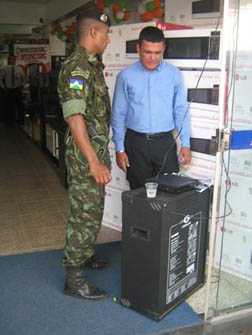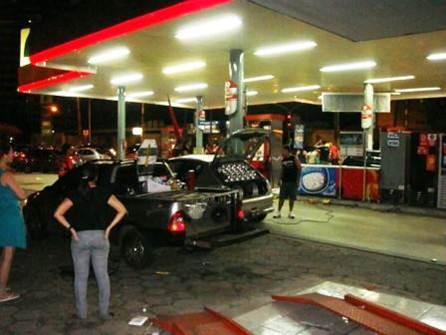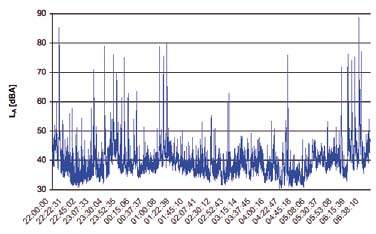

Stephan Paul – stephan.paul@eac.ufsm.br
Undergrad
Program Acoustical Engineering
Fed. University of Santa Maria
Santa Maria, RS, Brazil
Isabel Kuniyoshi – isabelck@saolucas.edu.br
Department of Speech and Hearing Sciences
F
aculdade Sao Lucas
Porto Velho, RO, Brazil
Popular version of paper 1pNSb6
Presented Monday afternoon, June 3, 2013
ICA 2013 Montreal
The Amazon Region is usually well known for its nature and not for the noise pollution that recently took over in many cities as a result of a quick and enormous increase in the number of vehicles and facilities like restaurants, bars, night-clubs and shops. Number of vehicles in the capitals of the Amazon region increased between 38% and 71% between 2007 and 2012. While traffic noise is a common problem worldwide, in urban settings of the Amazon region restaurants and bars have facades with large openings and young adults compete with high-power car sound systems, being therefore the most common sources of noise pollution and annoyance. Also huge loudspeakers in front or in shops or mounted on vehicles or motorbikes are used for advertising and several neighborhoods have loudspeakers fixed on light posts in order to spread out the program of a local community radio station. In some cities abusive use of automotive sound and shop loudspeakers are the most common reasons for citing persons before a court for environmental crimes.


Fig. 1: Two typical situations in Porto Velho and other cities in Brazil that cause noise pollution.
Despite the problem of noise pollution, usually no large and organized data-sets on noise pollution are available. Available data usually is collected during law enforcement and therefore not schematized nor representative for a whole day or the whole night.
In a first approach to understanding noise pollution in Porto Velho, capital of the state of Rondônia, where no representative data on noise pollution were available, organized measurements were carried out in the vicinity of schools and health care facilities, near street intersections with heavy traffic, close to shops, bars, restaurants and gas stops in different neighborhoods. Measurements were carried out to take so called A-weighted short time equivalent sound pressure levels (SPLAs), a magnitude which represents the energetic mean of the perceptible noise during one second. Thus, many thousands of these SPLAs, as graphed in Figure 2, were obtained and processed to find a single number that is representative for the whole period of measurement, e.g. the whole night. This single number quantity is called long term A-weighted equivalent sound pressure level, or LAeq, and is an energetic mean of all the SPLAs collected. It is not a simple mean because sound levels are logarithmic quantities, a fact that complicates calculus with sound levels.

Fig. 2: Example of A-weighted short time equivalent sound pressure levels (SPLAs) obtained during the night.
Considering the five neighborhoods LAeq was found to be 74 dBA during the day (7 AM to 7 PM) and 78 dBA at night, the latter measured close to restaurants and gas stations where noise pollution is most pronounced at night. 74 dBA to 78 dBA at night is indeed very noisy and corresponds to the double of noise sensation as found in many other cities at night where LAeq often do not exceeds 65 dBA (see [1]). Close to public schools LAeq ranged from 60 to 74 dBA between 7 AM and 12 AM, but maximum short time SPLAs were 77 to 98 dBA. This is quite noisy. From the data it is evident that SPLA and LAeq can be quite different and must be clearly separated. Also it must be observed that repeated measurements at the same measurement site can give very different results. Therefore care has to be taken when using the results obtained one day without knowing the situation at other moments in time.
Despite these limitations, the LAeqs measured far exceed the limits established by local state law and different Brazilian standards, even when local state law and standard are somewhat conflicting. The amount that the levels exceed limits is around 10 dB, which corresponds to more than eightfold the noise energy that would be allowed.
It was found that motorcycles, a mean of transport much more common in Brazil than in Europe or North America, produced up to 84 dBA SPLA at the receiver position. Vehicle break squeal produced up to 85 dBA SPLA and aircraft flyovers up to 98 SPLA. Children shouting, a very natural soundscape around schools, resulted in up to 72 dBA and advertising cars used by election candidates to pursue their voters produced up to 79 dBA SPLA.
As motorcycles without exhaust system or noise emitted by advertising cars is very annoying, many people advocate for their prohibition and state authorities might expect a reduction of the annoyance and the “noise level.” While the maximum SPLA and annoyance due to noise certainly would be reduced a simple simulation with the data obtained in the measurement around schools reveals that the LAeq would be unaffected when tuned or altered motorcycles or advertising cars were “withdrawn.” As actual state legislation and technical standards use LAeq as a measure of annoyance, withdrawing tuned or altered motorcycles or advertising cars would not have any effect in terms of better compliance with law or standard. This is also valid for the case of grounding all aircraft: in the case studied here grounding all aircraft would not reduce LAeq at all. To reduce annoyance, other criteria, complementary to LAeq, must be fixed in legislation and standards and considered in measurements.
In Rondônia several public authorities and private entities work now together against noise pollution and the International Noise Awareness Day is since its introduction in Brazil in 2008 [2] and in Rondônia (2009) [3] an important key date and network to elaborate, coordinate and carry out such actions. Actions and countermeasures include law enforcement, giving rise to penalties and alternative penalties, and educational activities. A program of environmental re-education is looking to sensitize the law breaker to environmental issues and to invoke a change in behavior. While most of the nearly thousand subjects sent to the alternative penalty environmental education program were judged for noise pollution none of them were fined once again for noise pollution. Other educational activities are being developed in a very large number of different places under the direct auspice of the Brazilian branch of the International Noise Awareness Day by students and faculty of Speech and Hearing Science from a local university together with police officers of the Environmental Police, representatives of the Office of the Federal Public Prosecutor in Rondônia, the Dept. of Environmental Issues of the Municipality, and other institutions. These actions have been found to be very successful in the battle against noise pollution.
References
(1) Jian Kang, Urban Sound Environment, Taylor & Francis, 2007
(2) S. Paul and I. C. Kuniyoshi, “The International Noise Awareness Day in Brazil - its
development, guidelines and key actions”, in Proc. of the 18th International Congress of
Sound and Vibration (2011).
(3)
I. Kuniyoshi, S. Paul, L. B. Rodrigues, V. Silva, A. Bassi, V. Perillo, L. Rodrigues, E. I. Taira, S. Barreto, M. Botelho, and F. Aurélio, “15º Dia internacional de Conscientização sobre o Ruído em Porto Velho, Rondônia”, in 26o Encontro Internacional de Audiologia (2011)